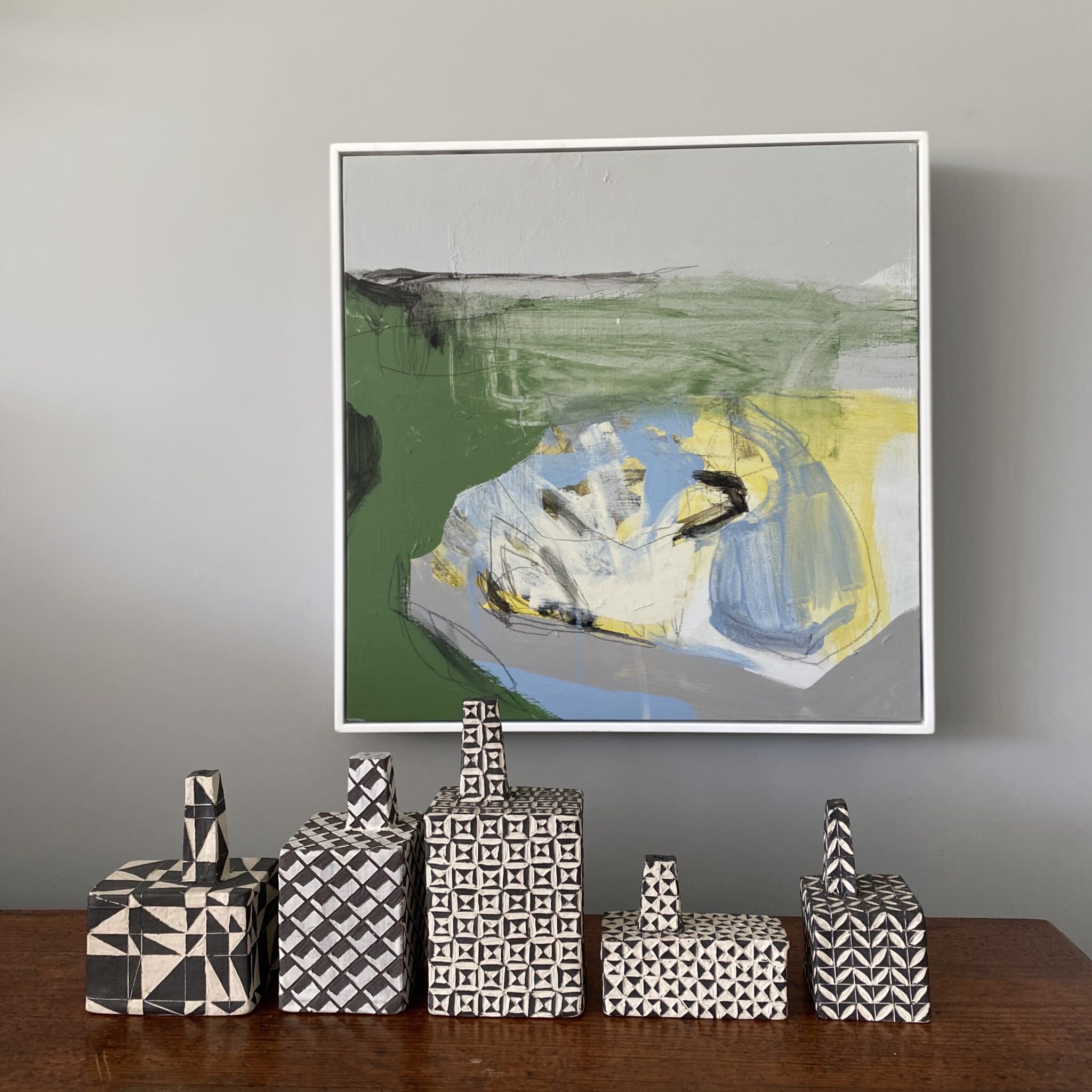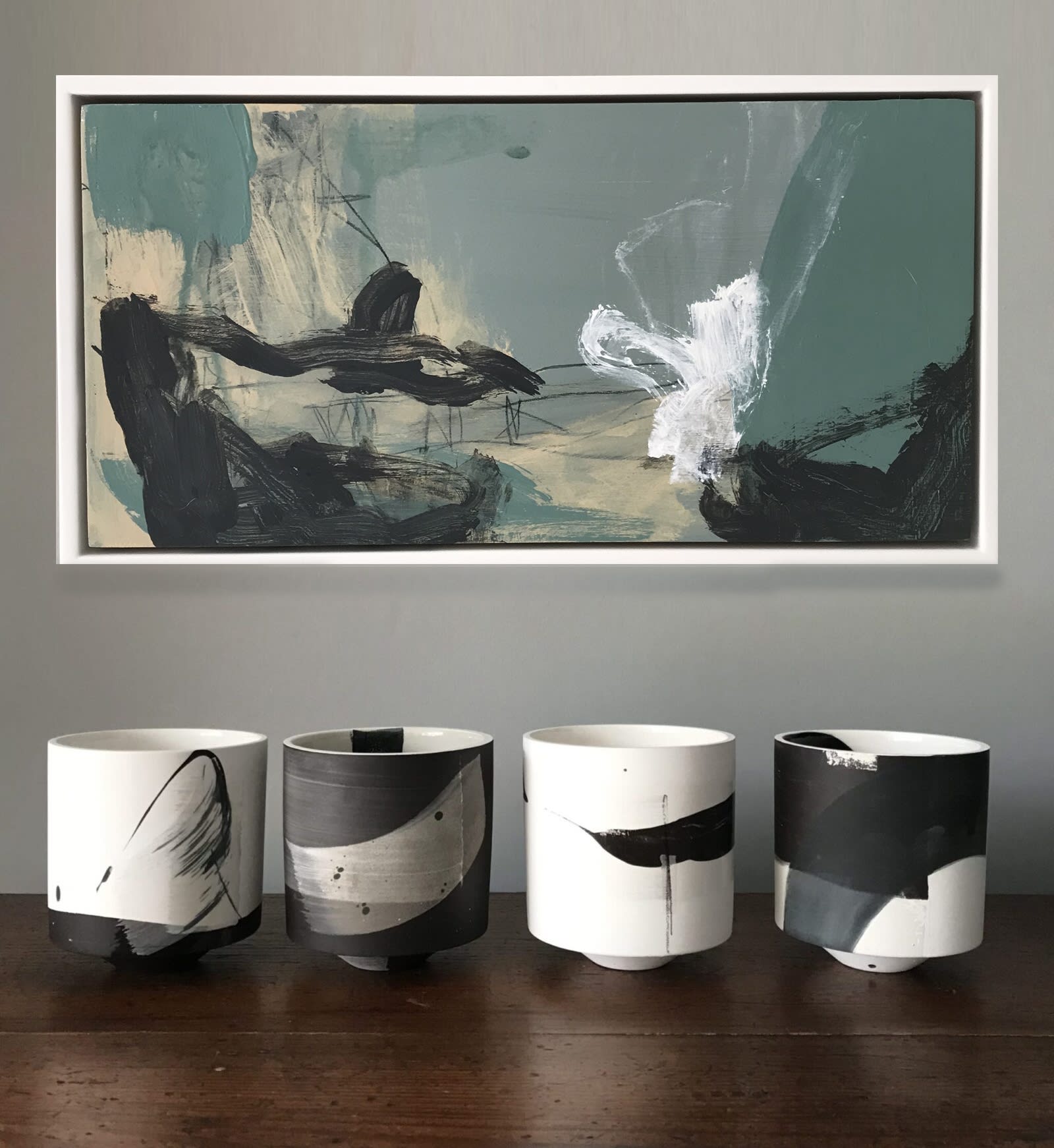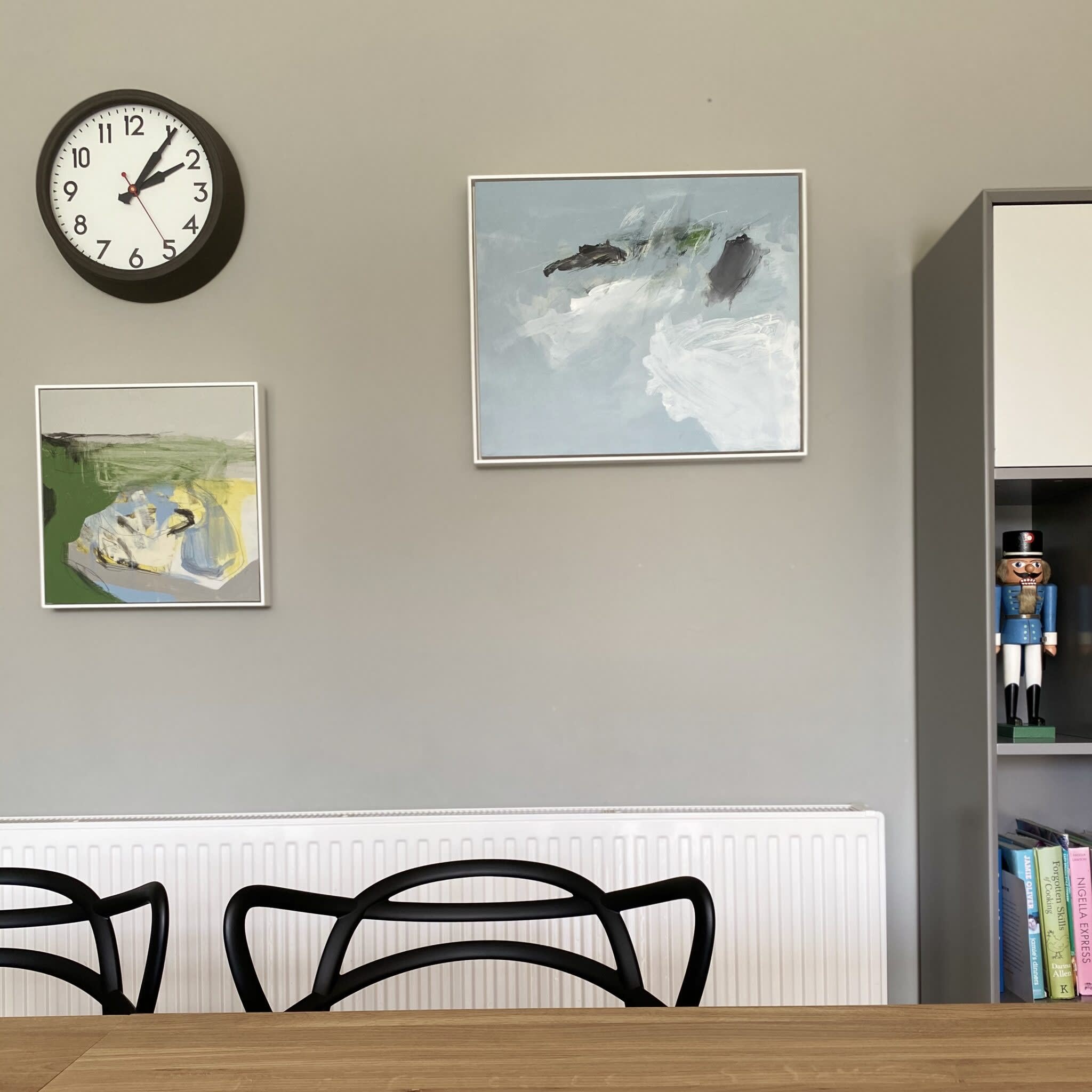-

Angela Charles: Always Godrevy, acrylic and coloured pencil on aluminium panel, 100 x 100 cm
Shown here with work by Björk Haraldsdóttir – Tapestry 2018 (sold) and Poet Stoneware, Black Slip, 57 x 37 cm, 2020I first fell in love with Angela Charles’ subtly coloured, abstract landscapes after seeing them during Somerset Art Weeks in 2008, shortly after moving from London to the South West with my family. I knew instantly that Juliana would love her work too, being a huge fan of Cy Twombly’s paintings and we’ve been working with Angela since that first viewing, showing her work in both London and Somerset over the years.
About ten years ago Angela started to experience problems with her vision. She was subsequently diagnosed with Retinal Dystrophy, an incurable eye condition which progressively leads to the loss of sight. Although her sight loss was more manageable initially, in the last two years, Angela’s sight has deteriorated significantly and she was recently Registered Blind. As you can imagine, this has been a very challenging time for Angela who has been a practising visual artist since she graduated from Goldsmiths in 1989, as well as working as a curator for a number of years. Apart from the practical and psychological adjustments that a person losing their sight has to go through, Angela was also faced with the anxiety of not knowing if she would still be able to paint and what and when she should tell her clients and the galleries that represented her work. She needn’t have worried though, as Angela’s innate and instinctive use of colour and mark-making means that she is producing work as beautiful as ever, possibly even more so.
This week we talk to Angela about her experience and about how she has embraced the changes in her life as an artist who is now registered blind.

Angela Charles and her Guide dog Flynn
CF: Angela, what is Retinal Dystrophy and how has it affected your sight over the last ten years?
AC: Retinal Dystrophy covers a range of disorders of the retina. Retinitis Pigmentosa or RP is the disorder I have which is an eye condition that leads to progressive sight loss for which there is no cure. Mine is ‘Atypical’ so it isn’t your usual RP (I’ve always liked to be different!) in my case, my central vision has gone before my peripheral vision. Over the last 10 years, I’ve gone from being able to read the bottom line on an eyesight chart and driving, to not being able to read the top letter and having a Guide Dog. It’s been a roller coaster of a decade!
It’s a common misconception that all people registered severely sight impaired (Blind) can’t see anything, this accounts for only about 5% of those registered Blind. I still have some useful vision. For me, this changes depending on light levels but usually, it’s like looking through dirty net curtains with the middle totally obscured.
Angela Charles: No Way Down, acrylic and coloured pencil on wooden panel, 40 x 40cm, framed
Shown here with a set of five geometric vessels by Björk Haraldsdóttir – similar set available for commission.CF: As a painter and curator that must have been a harrowing experience. How did it make you feel when you were told that you were going to eventually lose your sight?
AC: I didn’t believe it, to begin with. I didn’t know how I’d cope when I’ve always been such a visual person. My whole life revolved around experiencing and expressing myself visually. I was in denial for a very long time until I could no longer kid myself and others!
I’ve found losing my sight very hard to get my head around. As you know it won’t kill you and it isn’t painful but at the same time, it’s such a frustrating experience which I find hard to articulate.
Angela Charles: Towards the Bay, acrylic and pencil on bespoke framed wood panel, 15 x 30 cm
Shown here with Cut and Altered Vessel by Ashraf HannaCF: Was it difficult to talk about with other galleries and your collectors?
AC: Yes I found this daunting and I just couldn’t bring the subject up until very recently. Even keeping my Guide Dog in the van when delivering paintings with my husband so as not to give the game away.
I didn’t want people to pity me and treat me any differently. I also didn’t want it to put galleries or clients off my work or for my paintings to be a novelty. When I finally started to tell people it was such a relief. It felt like I’d been keeping a guilty secret for so long. It has been liberating.
Angela Charles: On the Edge, acrylic and coloured pencil on aluminium panel, 100 x 100 cm
Shown here with Recumbent Halo - sculpture by Sandra James (sold).CF: When painter Sargy Mann went blind he continued to paint. He was quoted as saying – “ It seems more or less impossible but if you are just determined to keep going you don’t need to give up because if your subject is your own experience then as long as you are having an experience you’ve got a subject.” Is this something you agree with?
AC: Yes I do. Painting has always been my way of expressing myself. It’s been about a response to something, be it a place or an experience, it’s about expressing what I feel or how I remember a place rather than a direct representation of somewhere. This hasn’t changed from having full sight to now, I’ve always found it easier with paint rather than use words.

Angela Charles: Cheerful Little Number, acrylic and coloured pencil on framed wooden panel 15 x 30 cm
Shown here with set of four Print Beakers by Hannah TounsendCF: Over the past five years or so Juliana and I have noticed an increased use of brighter colours in your work. What was a hit of red brought in by a pencil mark has become a more pronounced in your paintings and we’ve seen you work with brighter greens, blues, yellows and even pinks. We’ve really enjoyed this development. Do you think this has been one of the ways your work has changed as a result of your eyesight fading? Has your work evolved in other ways?
AC: Yes, where once there was a subtle bright pencil mark now for me to see it the brighter colours have to be applied by a brush. Some works, from say 10 years ago, I find impossible to see at all, I cannot distinguish any subtle variation of colour or marks, even with the help of technology. Although saying this, even some of my work now I can’t see once I’ve painted them, I just have to remember titles to remember how, when and why I painted a certain piece. If the colour is really bright and contrasts with the other marks and colours on the painting I can see these as they pierce through my dirty net curtain sight, but I have to look at strange angles to see colours – it’s called eccentric vision. Like walking past a field of buttercups, I might only notice as I walk away from the field as they show in the extreme periphery of my vision. I love it when my grey world is suddenly punctuated with a bright colour. It does make me wonder if my sight was deteriorating long before I realised, I’d often use a very calm area of a subtle colour with an area of more frantic mark making including a contrasting brighter colour. This is very much how my sight began to go, with my central vision being an area of calm and all the ‘action’ taking place around the peripheral.
In the majority of my work I’ve now become much bolder with my mark making and colours, however, having painted for so long, I know exactly what marks both pencils and individual brushes make so I can still use them when I want a certain mark, even if I can’t see what they’re doing. It’s the same with colours, I know what colours mixed together will make, so I can mix a very subtle colour without seeing it. Where I can see colour, I’ve learnt not to trust what I see. Due to RP’s effect on the cones in my eyes my colour vision is very bizarre, I point out colours I see only to be told they aren’t the colours I think they are, I actually find this intriguing and amusing.

Angela Charles: Catching My Breath, acrylic and coloured pencil on aluminium panel, 100 x 100 cm
Shown here with Recumbent Halo – sculpture by Sandra James (sold)CF: As this has been a journey with your sight deteriorating over the years, how have you prepared yourself knowing that you would eventually become blind? What strategies have you adopted now that your sight has gone to continue painting?
AC: Giving up curatorial work was hard and for a time and I wondered if I could continue to paint but I knew I had to find a way. I also knew that I’d been painting for so long, I could almost do it with my eyes closed and I’m lucky enough that there’s a lot of assistive technology out there. There is an app called Seeing AI which has meant I know what colour I’m painting with. I was going crazy trying to paint but not being able to read the labels on the paint tubes or see the colour of the paint. Now I just point my iPhone at a paint tube and the Seeing AI app speaks the colour to me, it’s been essential in continuing with my painting.

Angela Charles: It is what it is, acrylic and coloured pencil on framed wooden panel, 20 x 40 cm
Shown here with Apple and Pear Sculptures by Danuta SolowiejCF: Has your relationship with the work of other artists changed as a result of your condition?
AC: Yes, I have really changed my relationship with colour when it comes to the work of others. I am happy using subtle colours as I know what colours I’m painting, I don’t have to see the paint, but with other artists’ work, I find it hard to see unless they are bright or bold or big, preferably all three! The Jeff Koons exhibition at the Ashmolean in Oxford was the first exhibition I’d enjoyed with my Guide Dog, it was big and brash and I could enjoy many of the works without the aid of audio description. The game-changer for me though was Rose Wylie, her exhibition at Newlyn and The Exchange in Cornwall made me so happy. Her work made me realise I could not only carry on painting but really enjoy painting. Her huge figurative paintings with carefree brush strokes, exciting use of colour and her take on contemporary culture brought me to tears…in a good way.

Installation of Angela Charles’ paintings
CF:What are you working on at the moment?
AC: This year, despite the lockdown, I’ve been very fortunate to receive support and funding from Arts Council England to pursue an important personal project that looks at me ‘Coming Out As A Blind Painter’. This will include the production of a short film by the wonderful documentary filmmaker Liberty Smith and the production of a new body of work which comes out of my transition into a Blind Painter. Working in partnership with OSR Projects in West Coker in Somerset, and with additional support from South Somerset District Council, the film will premiere at Od Arts Festival in 2021. A resulting exhibition of the new work will be held at OSR in a fantastic old school room in Autumn of 2021. This project allows me to celebrate my sight loss rather than deny it, I’m hoping in a humorous and accessible way. It allows me time to experiment with new ideas and processes which will feed into my painting going forward. However, for me, it’s important that I use this opportunity to embrace my sight loss and to inform others about sight loss and disability.
CF: We’ll look forward to seeing that Angela. Good luck with the filming and thanks for talking to us today.